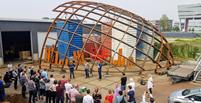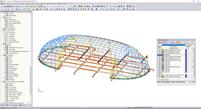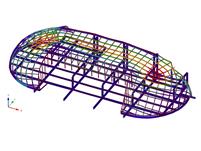The structure was designed by the well-known architectural firm of ZJA Zwarts & Jansma Architects. The project additionally won the prestigious MIPIM Award 2020 – Best Refurbished Building, the Dutch Steel Award 2020, and the German Design Award 2021.
The Octatube company carried out the structural design, utilizing the FEM program RFEM. Octatube is a design-build planning and construction company for complex architectural structures. The main design focus was placed on the use of steel and glass to implement a sophisticated architectural look for the roof, ranging from the design to the construction of the building.
Structure and Design
The roof's structural system is best described as a cylindrical grid shell with two domes at either end. Because of the roof's adjacent building and the opening for the facade's entrance, sections had been removed from the grid shell. In principal, the dome has only one repetitive structural joint, but the free shape creates differences at each joint, requiring unique parts. In total, around 1,000 different steel components and 200 glass panels were used.
For complex projects, flexible structural analysis and design software is needed that is capable of modeling a wide range of unique elements. Octatube utilized RFEM together with Rhinoceros (Rhino), Grasshopper, and IDEA StatiCa. During the preliminary and final design phases, the architect's Rhino-Grasshopper line model was used as the starting point. In this model, the main and secondary lines were set.
The model's grid lines and curvature were thoroughly analyzed and optimized. The line model and the structural loads from Grasshopper were imported into RFEM, where the model could be structurally optimized. The loads on the structure were generated with a direct connection between Rhino and a user-defined interface. For the indirect connection between Grasshopper and RFEM, Excel was used. The unique design requirement included the square glass surfaces to be completely flat, similar to the exterior of a diamond.
The rectangular hollow cross-section properties were determined with RFEM and IDEA StatiCa. Since the rotational stiffness was very important, two models of the entire structure and the joints were created in order to adequately model the stiffness and strength of the grid shell. These models were used as the upper and lower boundaries for the deformations and stiffness. The upper limit model included all joints as completely rigid to determine the load effects on the joints.
The lower limit for the rotational stiffness was determined iteratively between RFEM and IDEA CONNECTION for each joint type. This flexible joint model was used to check the stiffness and stability of the grid shell. The supporting structure, located under the grid shell, was also included to properly determine loads. This was necessary to avoid the time-consuming and iterative process of determining the vertical supports' spring stiffness, which would vary for each load case.
| Location | Weesperplein 4B 1018 XA Amsterdam, Netherlands |
| Owner | Zadelhoff B.V. Amsterdam, the Netherlands www.zadelhoff.nl |
| Architect | ZJA Zwarts & Jansma Architecten Amsterdam, the Netherlands www.zja.nl |
| Structural Analysis and Construction | Octatube Delft, the Netherlands www.octatube.nl |









